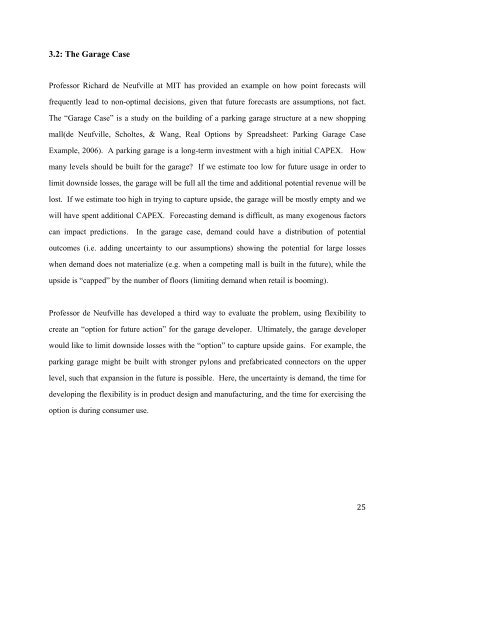A Case Study on Automotive Battery System Design - Title Page - MIT
A Case Study on Automotive Battery System Design - Title Page - MIT
A Case Study on Automotive Battery System Design - Title Page - MIT
- No tags were found...
You also want an ePaper? Increase the reach of your titles
YUMPU automatically turns print PDFs into web optimized ePapers that Google loves.
3.2: The Garage <str<strong>on</strong>g>Case</str<strong>on</strong>g>Professor Richard de Neufville at <strong>MIT</strong> has provided an example <strong>on</strong> how point forecasts willfrequently lead to n<strong>on</strong>-optimal decisi<strong>on</strong>s, given that future forecasts are assumpti<strong>on</strong>s, not fact.The “Garage <str<strong>on</strong>g>Case</str<strong>on</strong>g>” is a study <strong>on</strong> the building of a parking garage structure at a new shoppingmall(de Neufville, Scholtes, & Wang, Real Opti<strong>on</strong>s by Spreadsheet: Parking Garage <str<strong>on</strong>g>Case</str<strong>on</strong>g>Example, 2006). A parking garage is a l<strong>on</strong>g-term investment with a high initial CAPEX. Howmany levels should be built for the garage? If we estimate too low for future usage in order tolimit downside losses, the garage will be full all the time and additi<strong>on</strong>al potential revenue will belost. If we estimate too high in trying to capture upside, the garage will be mostly empty and wewill have spent additi<strong>on</strong>al CAPEX. Forecasting demand is difficult, as many exogenous factorscan impact predicti<strong>on</strong>s. In the garage case, demand could have a distributi<strong>on</strong> of potentialoutcomes (i.e. adding uncertainty to our assumpti<strong>on</strong>s) showing the potential for large losseswhen demand does not materialize (e.g. when a competing mall is built in the future), while theupside is “capped” by the number of floors (limiting demand when retail is booming).Professor de Neufville has developed a third way to evaluate the problem, using flexibility tocreate an “opti<strong>on</strong> for future acti<strong>on</strong>” for the garage developer. Ultimately, the garage developerwould like to limit downside losses with the “opti<strong>on</strong>” to capture upside gains. For example, theparking garage might be built with str<strong>on</strong>ger pyl<strong>on</strong>s and prefabricated c<strong>on</strong>nectors <strong>on</strong> the upperlevel, such that expansi<strong>on</strong> in the future is possible. Here, the uncertainty is demand, the time fordeveloping the flexibility is in product design and manufacturing, and the time for exercising theopti<strong>on</strong> is during c<strong>on</strong>sumer use.25
















